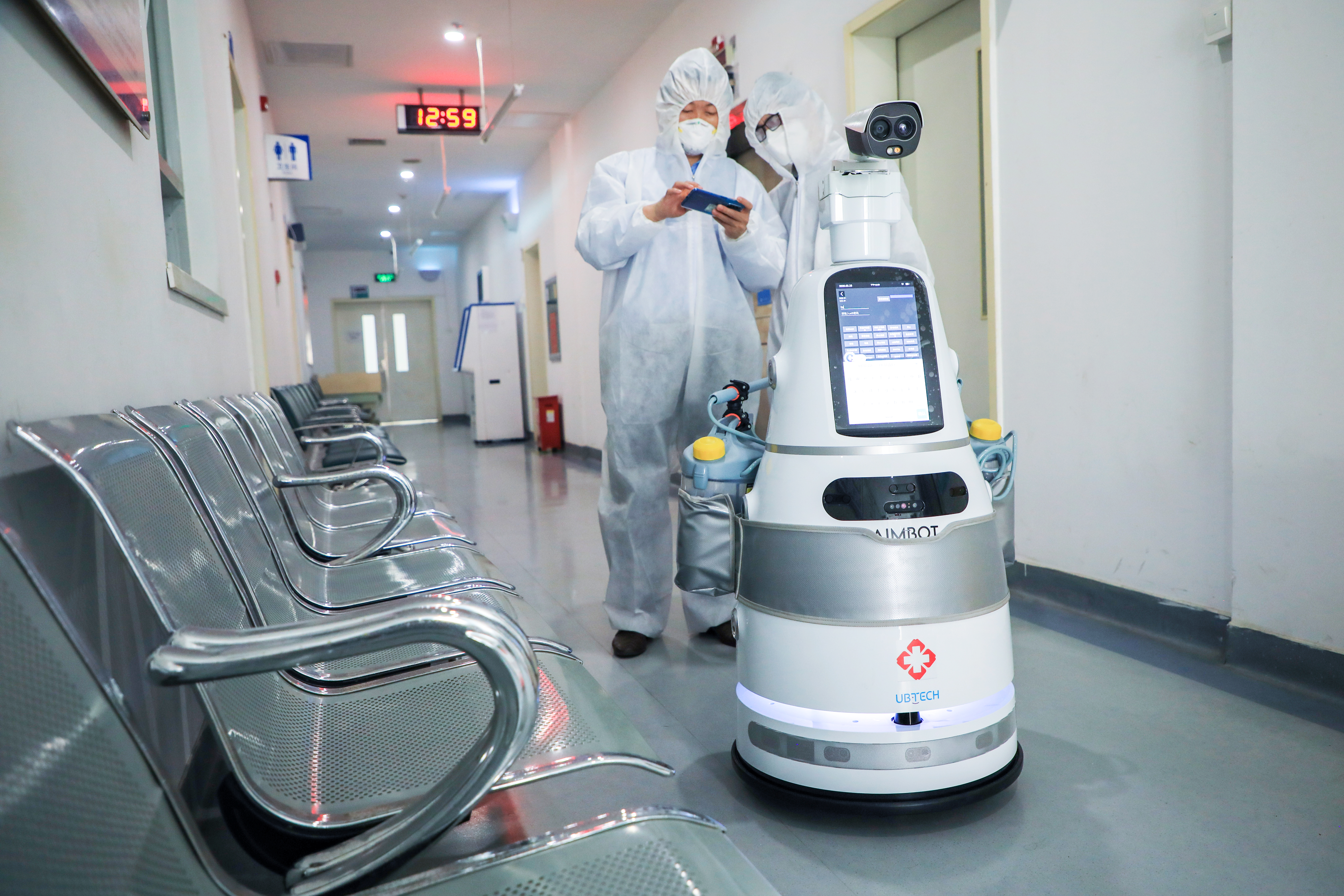Nursing robots are just one way China is using technology in response to the coronavirus epidemic.
The coronavirus is testing China’s disaster preparedness and response, from public health systems to information sharing. Yet China has a key advantage in this fight: its technology infrastructure.
As the coronavirus spreads, so too are innovations to combat it. Not only is technology making life in quarantine more livable for millions of people, but it is also helping to fight the virus.
1. The Code: Within the first few weeks of the virus, China had sequenced the genome. By posting that sequencing online, it trigged a ripple effect in research labs across the world, with a surge in orders for synthetic samples of the virus to build copies of it from scratch. This allowed new treatments to be trialed – even experiments that failed offered vital clues in guiding researchers on where they should focus.
2. The Skies: Drones are being dispatched to respond to the outbreak, across the country. From patrolling walkways with loudspeakers warning residents to wear masks, to hovering over streets with QR code placards that drivers can scan with their phones to register health information; the drones allow authorities to get information out faster while also keeping a safe distance while performing their duties. Agricultural drones are also spraying disinfectants in remote areas, while others have been used to deliver crucial medical supplies.
Drones used to spray disinfectant on city streets are 5 times more efficient than manual spraying
3. Our Phones: Smartphones are playing a critical role in reducing exposure. Delivery apps offer contactless delivery, whereby drivers drop food off at a specific point – including a card stating the temperature of everyone involved in cooking and delivering the food. Another offers users maps marking residential communities with confirmed cases and their proximity to them. Meanwhile, mobile payment apps are reducing transmission along paper money, which can carry viruses for up to 17 days. With the world’s highest penetration of e-wallets and two of the world’s largest mobile pay, Chinese fin-tech is helping to slow the coronavirus spread.
4. The Infodemic: As the virus began making headlines globally, false information also spread, it was labeled an ‘infodemic’ by the WHO. Yet while technology has facilitated misinformation, it is also helping to curb it. In China, a massive online mobilization of experts, universities, organizations (including UNDP), celebrities and even A.I. news anchors are battling the infodemic, urging everyone to “spread the word, not the virus.” For instance, sharing how to wear masks, and encouraging youth to share facts with the elderly and promoting social distancing.
Netizens participating in UNDP's the Spread the Word, Not the Virus campaign in over 30 different languages and dialects.
5. Business continuity: A major challenge during the virus is being able to work. Several tech companies are offering free online collaborative tools. Other businesses have quickly adopted work-from-home policies, using online meeting software, collaboration platforms and LBS technology to clock in and ensure employees stay home. At UNDP, the use of Zoom teleconferencing and ERP Platforms have allowed us to keep working.
6. Education and parents’ sanity: After weeks of schools being closed, possibly the biggest challenge for parents is keeping children occupied and continuing their schoolwork. To enable this, many Chinese schools have rolled out online learning platforms, where students take courses and teachers give lectures from home, via live-streaming platforms.
Students utilizing technology to study at home.
7. E-Medical and psychological care: From hypertension to arthritis, people still have many other medical needs. Online doctors and express deliveries of medicine are on the rise, as people avoid hospitals. Many institutions also offer online psychological counseling services – often for free – to counter the stress of social distancing.
8. Robot nurses and AI Diagnoses: Robots are also used in many Chinese hospitals to deliver food, medicine and other supplies to patients; to disinfect hospitals and other public areas; to check patients temperatures; and to answer common questions. Coronavirus is being diagnosed using AI, which can read thousands of CT scans in 20 seconds with an accuracy rate of 96%.
Robots are being used in hospitals in Wuhan to assist patients with questions, reducing the possibility of human contamination.
9. Connecting people: Compulsory quarantine has disrupted daily life and curtailed social interaction for nearly one fifth of the global population. This is leading millions to meet online instead. Families dine together with relatives in distant cities, raising a glass to each other on camera. Even weddings have been held in Virtual Reality.
10. Big Data dashboards: Transparent and accessible public data has facilitated the development of dashboards to track the spread of virus. This time around these dashboards are not only made by UN organizations like WHO, but also smaller organizations and enterprises that have contributed to their needs. Users can access these real time updates easily through their familiar Apps.
While the use of technology can at times present its own challenges, and fuel debates about privacy and public good; in the fight against the coronavirus, it is playing a critical role in offering treatment, information, support, food, schooling and greater safety for many.
---
Authored by Mr. Devanand Ramiah, UNDP Deputy Resident Representative in China

 Locations
Locations




